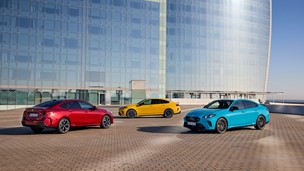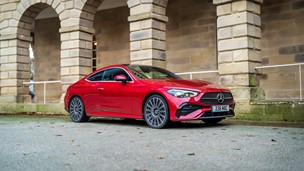Now in its third generation, the 6 was launched in its current form in 2013 and reworked in 2015 with revised styling, equipment and suspension settings, among other things. An attractive family saloon whose rivals include the Ford Mondeo and Vauxhall Insignia, it's the second Mazda after the CX-5 to have been designed on the company's SKYACTIV principles.
There's a 2.0-litre petrol engine and a 2.2-litre diesel, both with a choice of power outputs. All but the more powerful petrol unit are available with automatic transmission in place of the standard six-speed manual.
The car's appeal to UK customers is not helped by the fact that there is no hatchback body style. In standard form it's a saloon, and if you want more practicality you'll have to choose the Tourer estate instead.
Performance
The most powerful version is the 173bhp 2.2-litre diesel, which with manual transmission has a 0-62mph time of 7.9 seconds, and a top speed of 139mph.
The slightly less powerful 148bhp diesel is, however, expected to be more popular, and it does seem the more sensible choice, since it accelerates to 62mph in the same 9.1 seconds as the 163bhp petrol models (9.1 seconds) and is the most economical engine in the range by quite some margin.
Another reason to view the 173bhp unit with suspicion is that, as we'll see, it slightly overpowers the rest of the car. This is not a problem with any of the others.
Mazda's 2015 upgrade included improving the overall noise suppression, and while there are still a few rumbles when pushed hard, it's relatively quiet and refined, even at motorway speeds.
Ride and Handling
The diesels are slightly less poised, but there's still plenty of grip alongside direct, well-weighted steering.
One thing that impressed us with the 2013-14 cars was that they behaved in much the same way no matter which type of engine was fitted. That has changed. The petrol models ride fairly well (though better on 17-inch wheels than on the 19-inch versions available as standard on the Sport Nav) and handle better. The diesels are slightly less poised, but there's still plenty of grip alongside direct, well-weighted steering. Manual gear change quality is not a Mazda strong point, and in the latest 6 the shift feels notchy, though to be fair this is on the basis of having driven only low-mileage examples at the time of writing. The automatic moves from one ratio to the next very smoothly and acceptably quickly. The other major controls are pleasant to use, the steering being particularly smooth. Low-speed manoeuvres can be performed easily unless you're reversing, in which case the rear pillars obscure visibility quite badly.
Interior and Equipment
The 6 was on the three-car shortlist for 2013 World Car Design of the Year, along with the Aston Martin Vanquish and the winning Jaguar F-Type.
The 2015 update includes a redesign of the interior, which is considerably more upmarket than it used to be. The seats are comfortable and supportive, and there is sufficient room for tall adults in the rear as well as the front. Luggage capacity is 483 litres, some way short of the Vauxhall Insignia's 530 and the 541 of the Ford Mondeo. To add to the Mazda's problems, those rivals are both hatchbacks. The 6, being a saloon, has a much smaller boot opening than either. On the plus side, the rear seats can be folded down to increase the load space to over 1,600 litres. The basic trim levels are called SE, SE-L and Sport Nav. The last of these includes satellite navigation, which is added to the other two specifications to create the SE Nav and SE-L Nav. All versions have DAB digital radio, air-conditioning, cruise control, an electronic parking brake, a multimedia system with a 7-inch colour touchscreen, Bluetooth connectivity, USB and iPod sockets, a start button and tyre pressure monitoring. Sport Nav models have full leather upholstery, heated front seats, Bose surround-sound audio and a head-up display. Like the SE-L, they also have Mazda's Smart City Brake Support system, intended to reduce the risk of low-speed accidents.
Cost
The 148bhp manual diesel has potentially the lowest running costs. Combined fuel economy is an impressive 68.9mpg, while CO2 emissions are 107g/km.
As well as being roughly in the middle of the range in terms of performance, the 148bhp manual diesel has potentially the lowest running costs. Combined fuel economy is an impressive 68.9mpg, while CO2 emissions are 107g/km, so Vehicle Excise Duty payments are £20 from year two onwards and the Benefit In Kind rating will be 19 per cent from April 2015, then 18 per cent, 20 per cent and 22 per cent in each of the next three financial years. Automatic transmission knocks 10mpg off the combined economy and adds 20g/km to the official CO2 emissions. The best figures in the petrol range are 51/4mpg and 129g/km, while the worst overall are 47.1mpg and 139g/km for the 143bhp petrol automatic, which is marginally worse than the 163bhp manual. Just one model, the 143bhp petrol manual SE, costs under £20,000, with a list price of £19,795. Diesels are priced £2500 higher, the most expensive of all being the £27,995 173bhp diesel Sport Nav automatic.
Our Verdict
When it was first launched, the 6 was one of the best-looking medium-sized family cars on the market, and the 2015 development hasn't changed that at all. The interior is also much improved. The fact that there's no hatchback version of the Mazda 6 is disappointing, and while the diesels make more economic sense if you plan to rack up a high mileage, we'd for a petrol model every time on the basis of their superior driving experience.




